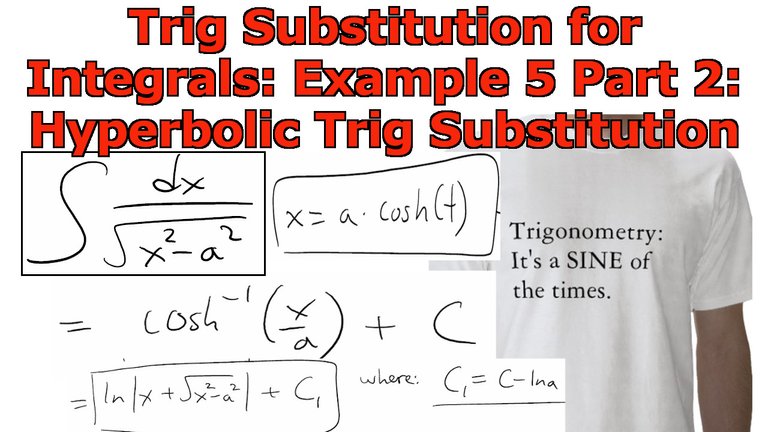Trigonometric Substitution for Integrals: Example 5 Part 2: Hyperbolic Trig Substitution
In this video I go over the same example 5 on trig substitution for integrals which I did in my last video but this time solve it using hyperbolic trig substitution instead. Although using hyperbolic trig substitution in this example is more complicated, I wanted to illustrate that there were other methods of solving the same integral. The final answer we get using this method is in the form of an inverse hyperbolic trig function but when writing this function as a logarithmic function, we get the same answer as we did in my last video.
Watch Video On:
- DTube: https://d.tube/#!/v/mes/lp6t8urbckf
- BitChute: https://www.bitchute.com/video/GyNeGSMdhwXu/
- YouTube: https://youtu.be/zxqwtjYDdwI
Download Video Notes: http://1drv.ms/1PBxIFY
View Video Notes Below!
Download These Notes: Link is in Video Description.
View These Notes as an Article: https://steemit.com/@mes
Subscribe via Email: http://mes.fm/subscribe
Donate! :) https://mes.fm/donateReuse of My Videos:
- Feel free to make use of / re-upload / monetize my videos as long as you provide a link to the original video.
Fight Back Against Censorship:
- Bookmark sites/channels/accounts and check periodically
- Remember to always archive website pages in case they get deleted/changed.
Join my private Discord Chat Room: https://mes.fm/chatroom
Check out my Reddit and Voat Math Forums:
Buy "Where Did The Towers Go?" by Dr. Judy Wood: https://mes.fm/judywoodbook
Follow My #FreeEnergy Video Series: https://mes.fm/freeenergy-playlist
Watch my #AntiGravity Video Series: https://steemit.com/antigravity/@mes/series
- See Part 6 for my Self Appointed PhD and #MESDuality Breakthrough Concept!
Follow My #MESExperiments Video Series: https://steemit.com/mesexperiments/@mes/list
NOTE #1: If you don't have time to watch this whole video:
- Skip to the end for Summary and Conclusions (If Available)
- Play this video at a faster speed.
-- TOP SECRET LIFE HACK: Your brain gets used to faster speed. (#Try2xSpeed)
-- Try 4X+ Speed by Browser Extensions or Modifying Source Code.
-- Browser Extension Recommendation: https://mes.fm/videospeed-extension
-- See my tutorial to learn more: https://steemit.com/video/@mes/play-videos-at-faster-or-slower-speeds-on-any-website- Download and Read Notes.
- Read notes on Steemit #GetOnSteem
- Watch the video in parts.
NOTE #2: If video volume is too low at any part of the video:
- Download this Browser Extension Recommendation: https://mes.fm/volume-extension
Trigonometric Substitution for Integrals: Example 5 Part 2: Using hyperbolic trig substitution

In my last video I solved the following example:

I used the following trig substitution to solve it:

And the answer we got was:

If we only consider when x > 0, then another method of solving this example is by using the following hyperbolic trig substitution:

We need to ensure that a*cosh(t) has a one-to-one relationship while maintaining the domain of x > a




Note: As shown in this example, hyperbolic trig substitutions can be used in place of trig substitutions and sometimes they lead to simpler answers. But we usually use trig substitutions because trig functions and trig identities are more familiar than hyperbolic functions and identities.